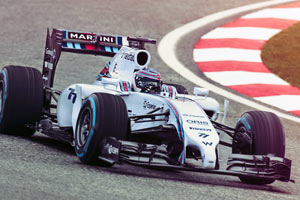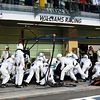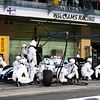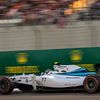Williams FW36 Mercedes

Active: 2014
Team: Williams F1
Team: Pat Symonds (CTO), Jason Somerville (CA), Ed Wood (CD), Dickie Stanford (TM), Rod Nelson (CTE), Frank Williams (TP), Claire Williams (DTP)
Drivers: Felipe Massa (19), Valtteri Bottas (77), Felipe Nasr (Reserve), Susie Wolff (Development Driver)
Team name: Williams Martini Racing
The Williams FW36 debuted on 28 January at Circuito de Jerez, Spain. It did however only complete a small number of laps, as the team, like many others, struggled with electrical issues on its new car.
According to Williams, the FW36 is one of the most technologically advanced Formula One cars ever product by the team. It's the result of two years of development and research by the team's technical departments in Grove.
Heading the Williams engineering department is Pat Symonds, and although he came in too late to have a really big impact on the basis of the Williams design, the signs from within the team were positive and new hires were announced to help the team progress. Such had not been possible with Mike Coughlan, the team's previous technical director as he had been a much talked about figure in the sport following his involvement in McLaren's spygate.
The FW36 is the very first in the team's history to be powered by a Mercedes engine, a partnership which Pat Symonds said he was very impressed about: Their professionalism and commitment have been notable and we’re as confident as we can be that the power unit will be competitive.”
The design phase of the FW36 was completed by mid-September, by which time the team had found solutions to the major challenges presented by the regulations. Cooling, weight, a new gearbox and aerodynamic changes are just some of the areas of focus. The new eight speed gearbox is still a Williams design but was tested on the Mercedes dyno in Brixworth from the beginning of November 2013, before running with the full power unit several weeks later.
Symonds also mentioned at the time of the launch that the team managed to keep the car below it's minimum weight of 691kg, allowing for some ballast to be positioned where most useful for the car's balance: “It’s been a challenge to get the car down to the weight limit. It’s been achievable, but it hasn’t been easy because the new power unit is heavier than the outgoing V8.”
As of the launch, the car featured a very neat and clean design, having a fairly tiny nosecone with an elephant's nose, allowing as much air as possible to go underneath while still be within the regulations of the limited nose height. Contrary to many other cars seen at Jerez, the sidepods still featured a sizeable undercut to help diffuser performance. Uniquely, the FW36 also had a wing mounted very low above the car's floor, attempting to replicate the effect that the banned beam wings used to have.
In further pre-season testing at Bahrain, the team ran its FW36 competitively and very reliably with just a single on-track stoppage on the final day of testing due to high mileage on the car's engine. The team revealed it had hit all its reliablity targets, contrary to most others who were still fixing issues ahead of the first race.
One week after the end of testing, on 6 March, Williams officially unveiled its partnership with Martini and also revealed its new livery. Founder and team principal Frank Williams said: “In testing the car has covered an impressive amount of mileage, which is testament to the hard work of everyone in the factory and our colleagues at Mercedes. We have developed a very strong working relationship with them which has proved vital in understanding the new power unit and maximising its performance. We head to Australia next week excited about the season’s prospects.”
Specifications
Chassis construction: Monocoque construction laminated from carbon epoxy and honeycomb surpassing FIA impact and strength requirements
Front suspension: Double wishbone, push-rod activated springs and anti-roll bar
Rear suspension: Double wishbone, pull-rod activated springs and anti-roll bar
Dampers: Williams
Wheels: RAYS forged magnesium
Tyres: Pirelli, Fronts: 245/660-13, Rears: 325/660-13
Brake system: AP 6 piston front and 4 piston rear calipers with carbon discs and pads
Steering: Williams power assisted rack and pinion
Fuel system: ATL Kevlar-reinforced rubber bladder
Electronics: FIA standard ECU and FIA homologated electronic and electrical system
Cooling system: Aluminium oil, water and gearbox radiators
Cockpit: Six point driver safety harness with 75mm shoulder straps & HANS system, removable anatomically formed carbon fibre seat
Dimensions
Weight: FIA Minimum (693kg)
Overall length: 5000mm
Overall height: 950mm
Overall width: 1800mm
Transmission
Gearbox: Williams eight speed seamless sequential semi-automatic shift plus reverse gear, gear selection electro-hydraulically actuated
Clutch: Carbon multi-plate
Powertrain
Designation: Mercedes-Benz PU106A Hybrid
Type: Turbocharged, 90° 1.6l V6, assisted with kinetic and heat ERS
No of valves: 24 (4 per cylinder)
Fuel injection: High-pressure direct injection (max 500 bar, one injector/cylinder)
Pressure charging: Single-stage compressor and exhaust turbine on a common shaft
Bore: 80mm
Stroke: 53mm
Crank height: 90mm (minimum allowed)
Energy recovery system: Integrated Hybrid energy recovery via electrical Motor Generator Units
Energy Store: Lithium-Ion battery solution, between 20 and 25 kg, by Mercedes AMG HPP







